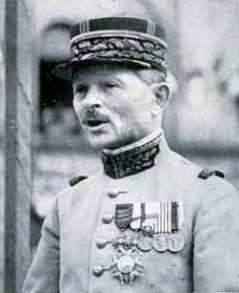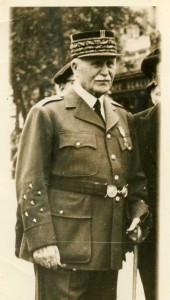General Weygand & Vichy France

General Maxime Weygand
General Maxime Weygand (1867-1965) of France would be celebrating his 145th birthday today. Like most top military leaders of the Second World War, Weygand had proved his dedication to his adopted country in the First. Actually born in Belgium to parents he would never know, Weygand gained French citizenship by adoption after a tumultuous but still privileged childhood (many historians believe he was the illegitimate child of royalty).
He graduated from the French military academy in St. Cyr in 1887. Promoted to Lieutenant Colonel by 1918, Weygand was present as Marshall Foch’s Chief of Staff at the signing of the Armistice ending World War I. Once peace in Western Europe was reached—albeit temporarily—Weygand led French troops fighting alongside the Poles in the Polish-Soviet War in 1920, and held a post in Syria until his retirement in the mid-1930s.
His departure from the army, however, wasn’t permanent. In May 1940, Prime Minister Reynaud recalled Weygand to service as commander in chief of the French Army. Just a month after his appointment, Weygand led troops against the Germans but was quickly overwhelmed and forced to retreat. He recommended a Franco-German armistice be signed. While some saw this as weak and traitorous, Weygand believed that French leadership should remain in France and endure with its people, rather than move to North Africa as Reynaud desired, leaving la patrie and les citoyens leaderless against the Huns.
To remain in France required surrender to Germany, and ultimately led to the development of what we know as the Vichy government, or Vichy France. In the minority of those refusing to surrender, Reynaud resigned as Prime Minister after less than three months in office, only to be replaced by the now notorious collaborationist Marshal Pétain. Ironically, Weygand sought an agreement with the Germans so that he could remain in France, but was instead sent to lead colonial troops in North Africa. Weygand would never again fit in; he was disliked by elements of the new French regime that had essentially banished him across the Mediterranean, and was even more distrusted by the Germans who forced Pétain to recall Weygand to France in late 1941.
The Germans were right to suspect Weygand. He never dreamed of or desired collaboration with the Germans, and when collaboration became the only reality, he resigned from the armed forces. Once again, however, his resignation was not permanent. The Allies invaded North Africa in November 1942, and Pétain sought Weygand’s military know-how. Not surprisingly, Weygand advised Pétain to turn his back on the Germans and join the Allied fight. For this advice, Weygand was imprisoned by the SS until liberated in 1945.

Philippe Pétain, June 1942. Photo Gift of Brian Thompson, 2011.277
What is Vichy?
The Vichy Regime lasted from the summer of 1940 when the French leadership then under Pétain agreed to an armistice with Germany, through August 1944 when the Allies liberated France following the success of the Normandy landings. The Franco-German armistice essentially divided France in two; the northern zone would be fully occupied by the Germans, while the south would be allowed to remain under French control, albeit French collaborationist control.
This puppet government set itself up in the city of Vichy, hence the name of the regime. Its leaders, most famously Pierre Laval, Marshal Pétain and François Darlan, were opportunists. When times working with and under the Germans were good, they lived by their newly-coined, fascist-inspired motto “Travail, famille, patrie,” or “Work, Family, Homeland.” When the alliance with Germany wasn’t so good, they dreamed of ways to return to the true French belief of “Liberté, égalité, fraternité.”
The role of Vichy remains controversial. While it is correct that much of the Vichy government did collaborate, to the worst degree, with German occupiers and Nazi doctrine, others like Weygand had better intentions. He had hoped to protect his people from the misery of occupation, and to join the Allies when the time came. Weygand, however, was in the minority. Under Vichy rule, thousands of French Jews were deported and interned, and all but a token number of French troops were taken as prisoners of war as outlined in the armistice. The French malice mirrored the Gestapo, constantly seeking out partisans and torturing them for information. The French were also made responsible for paying the occupying troops, perhaps a small revenge for the humiliating terms of the Treaty of Versailles.
When it became clear the Allies were closing in, Vichy leadership fled to Germany where most were arrested and charged with war crimes. Pétain was tried and convicted, but spared the death sentence by Charles de Gaulle. He died after six years of solitary confinement in prison. Weygand was tried, perhaps more as a formality, tried for similar charges after his years of imprisonment. He was not convicted, and was released in May of 1946. He passed away in his beloved Paris at the age of 98.
This post by curator Meg Roussel
- Posted :
- Post Category :
- Tags :
- Follow responses to this entry through the RSS 2.0 feed. You can skip to the end and leave a response. Pinging is currently not allowed.




Leave a Reply